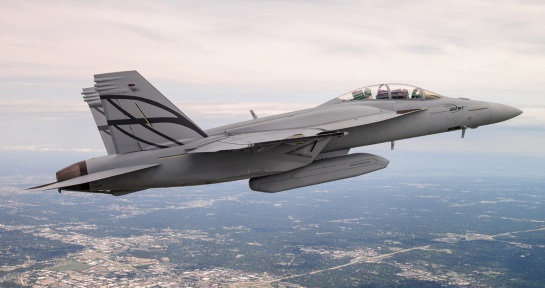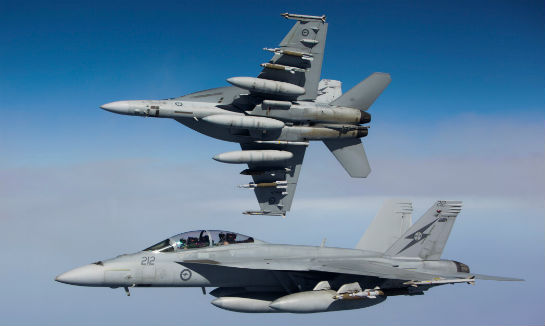Estimated reading time 10 minutes, 30 seconds.

According to recent news reports, Canada may be considering a fleet of Boeing F/A-18 Super Hornets to ensure it does not face a fighter jet capability gap by the 2020s. Boeing Photo
The Canadian government would like to acquire a fleet of Boeing F/A-18 Super Hornets, according to the Ottawa Citizen. And much like the government of Australia, it would bill the potential buy as an “interim” solution to address a pending “gap” in its fighter jet capability.
Quoting a senior official, the Citizen reported Monday that while no formal decision has been made, the federal Cabinet discussed the issue last week and has “made up their minds and are working on the right narrative to support it.”
Speaking to a defence industry trade show in late May, National Defence Minister Harjit Sajjan admitted that by “the 2020s we can foresee a capability gap” as the 30-year-old CF-188 Hornets experience more costly repairs and prove difficult to maintain.
“It needs to be dealt with quickly,” said Sajjan, acknowledging that the department is “risk managing a gap between our NORAD and NATO commitments and the number of fighters available for operations…The fact that they have not been replaced means we are facing a capability gap in the years ahead. [T]his I find unacceptable and I do plan to fix.”
During the election campaign, the Liberals pledged that the Lockheed Martin F-35A Joint Strike Fighter would not be a candidate for the CF-188 replacement program. According to the Citizen, despite promising an open and transparent competition, the government has been wrestling with how to keep the so-called fifth generation stealth fighter out of a contest without incurring “a multi-billion-dollar lawsuit.”
In 2011, the Royal Australian Air Force bought 24 F/A-18F Super Hornets “commercial-off-the-shelf” for $2.5 billion. It was an interim measure to deal with a potential capability gap due to the age of its General Dynamics F-111 Aardvark jets and legacy F/A-18A/B Hornets, and possible delays with the acquisition of 72 F-35A fighters, scheduled to reach full operating capability in 2023.
Canada may be facing similar “age” concerns. In recent interviews with pilots and technicians, many returning from Operation Impact in Iraq and Syria, Skies was told that while the CF-188s exceeded expectations and were in high demand because of their range and payload, many have maxed the capability of their electronic power systems and have parts that must be changed more frequently. An interim measure would likely postpone a replacement competition until after the next election in 2019.
If the Liberals are, in fact, leaning toward an interim measure, LGen Mike Hood may have tipped the government’s hand. In April, the commander of the Royal Canadian Air Force told an aerospace innovation forum in Montreal that domestic requirements would supersede all others.
“[The] statement of requirements [is] first and foremost written for a defence of Canada role,” he said. “The fact that it may also have expeditionary capabilities is irrelevant to the discussion because both the number of aircraft and the requirements of that aircraft are built on a solution for…the defence of Canada.”
While the military usually touts the “home game” as its top priority, Hood’s comments appeared to suggest a fighter capability best suited to NORAD missions and survivability in Arctic operations.
During a briefing at CANSEC in May, Ricardo Traven, a former CF-188 pilot and Boeing’s chief test pilot for F-18 programs, highlighted a number of attributes that make the Super Hornet ideally suited for northern operations, including twin engines, corrosion resistance, and rugged landing gear. Built to operate off an aircraft carrier, the Super Hornet’s ability to land on a dime has huge implications for pilots attempting to stick short, icy or partially plowed runways.
“It is something we have taken for granted for close to 30 years now, that we can fly at low approach speeds, touch down on the spot we need to touch down on, and we can crunch it down without having to flare because we have navy landing gear, we have two nose gear tires,” he said. “The Super Hornet, even though it is a bigger airplane, because of our big flaps and big stabilizers, actually lands slower than the legacy Hornet.”
Traven also noted two features that have not received much attention: folding wings and buddy tanking. Stand in a hangar at one of the tactical fighter squadrons in 3 Wing Bagotville, Que., and 4 Wing Cold Lake, Alta., or a forward operating base, and the value of the former quickly becomes apparent—foldable wings mean more room to fit more jets. And, because the Super Hornet was designed so that all maintenance, including an engine change, could be conducted “in the shadow of the airplane,” repairs can be made without moving other aircraft.

The Super Hornet is also the only fighter jet at the moment that can be configured with an air-to-air refuelling tank and probe. Neither Cold Lake nor Bagotville have resident tankers, so pilots are dependent on tanker support from 17 Wing Winnipeg or 8 Wing Trenton during NORAD operations.
“It is a tremendous capability that is kind of unspoken in this competition so far,” Traven acknowledged. “But the Hornet pilots, they cannot believe what [an advantage] that will be…because we are always thinking about what we are going to do about gas for this NORAD mission.”
Just how many Super Hornets the Canadian government might acquire remains unclear. But it would not take many to have an impact, Traven said.
The new jet would be familiar to any pilot of the legacy fleet, minimizing training requirements. But the enhanced, combat-proven capability would represent a giant leap forward, he said. As Australia discovered, “The moment the first Super Hornet shows up, you have just bought an upgrade program to all the other Hornets…[A]ll of a sudden it shares all of its information with the other Hornets. It only takes one and the whole squadron gets that much better. You can phase the [legacy] Hornets out over time.”
In recent months, Boeing has been making a more aggressive pitch about the Super Hornet’s well-established operational and maintenance costs and emphasizing the company’s sizeable footprint in Canada and its commitment to meeting industrial and technological benefits (ITB) obligations.
“We have successfully completed $6.7 billion in ITB obligations and we are working to liquidate the balance, which is about $2.9 billion,” said Roger Schallom, senior manager for international strategic partnerships. The renewal of the F-18 platform would mean new investment in long-term manufacturing, small businesses, technology and innovation with universities, supplier development, and more work for Canada’s in-service support infrastructure.
A Canadian acquisition program, even for a small number, would help ensure the F/A-18 production line remains strong for at least another five to 10 years. Roberto Valla, vice president for global sales, confirmed that the U.S. Navy’s chief of naval aviation has indentified a potential shortfall of up to 100 Super Hornets. The USN has requested 14 additional Super Hornets as part of the fiscal year 2017 budget and 14 more for 2018, which would extend the production line into the 2020s.
“We have many near-term opportunities on the horizon that will take our production well into the next decade,” said Valla. “We are confident we will be building the Super Hornet…well into the 2020s.”
More important, the USN has invested in a spiral development program that will see the Super Hornet out through the 2040s. “When we designed the aircraft, based on U.S. Navy specifications, they said: ‘Give us room for growth. Give us enough electrical power, give us enough real estate, and give us an architecture to be able to introduce new capabilities as the threats evolve.'”
If there is any fear that a delay in the competition will allow the F-35A more time to mature, to prove its capability, and to reduce its price tag and operational costs, Boeing doesn’t seem concerned. Traven said it was actually harder to make an argument against a paper airplane.
“The warts are starting to show,” he said. “The real costs and the real capability are starting to come out. I have zero fear of any product in development catching up. We’re not static, either. We are moving ahead, too. So bring it on.”








